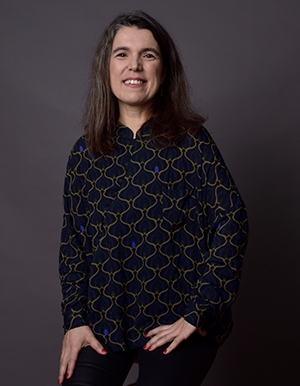Manuela M. Pereira Lab
Metalloproteins and Bioenergetics Unit

 |
The Biological Energy Transduction Group addresses a fundamental process for all living organisms: energy conservation. A wide range of biochemical and biophysical techniques is used to investigate the mechanisms of energy transduction by membrane respiratory chains |
|
Manuela M. Pereira Phone (+351) 214469321 | Extension 1321 |
|
 |
Research Interests
Life depends on constant energy transduction mechanisms.
Non-photosynthetic organisms obtain energy by degradation of all food components, such as proteins, glycides and lipids which feed electrons to the respiratory chain. Here the electron transfer is coupled to the translocation of ions across the cytoplasmatic membrane and the energy thus released by the favourable electron transfer is transduced to the form of a transmembrane difference of electrochemical potential, which dissipation through the ATP synthase allows the synthesis of ATP.
In our group we study the molecular mechanisms of electron transfer, ion translocation and their coupling. As model systems we use respiratory chains and their components. The research involves isolated proteins (wild type and variants) as well as reconstituted proteins or even membrane vesicles. We perform a multidisciplinary approach using a wide range of biochemical and biophysical techniques. The group is part of the Metalloproteins and Bioenergetics Unit and has several collaborations within ITQB NOVA, as well as outside the institute.
Specifically, we have been dedicated to investigate energy conservation by Complex I from the thermohalophilic bacterium Rhodothermus marinus, namely investigating its electron transfer kinetics and quinone reduction, proton and Na+ translocation and the coupling mechanism of electron transfer to ion transport. The investigation may also in the future, contribute to more applied areas, such as health, since Complex I malfunctioning has been shown to be implicated in several pathologies, namely neurodegenarative diseases like Parkinson and dystonia disorders.
We are also addressing protein-quinone interaction. For these studies we have elected type II NADH:quinone oxidoreductases (NDH-2) as model systems and we aim at investigating their catalytic mechanism and the interaction with the substrates. It is also our goal to recognize the structural elements/motives determinant for catalysis and substrate interaction. Having the advantage of working with NDH-2 that are present in organisms which express different types of quinones we aim to elucidate the characteristics and specificity of the binding sites for the different types of quinones.
The catalytic and energy conservation mechanisms by the recently described alternative complex III are also investigated. Studies on oxygen reductases, the last enzyme of respiratory chains, are being performed in strait collaboration within the Metalloprotein and Bioenergetic Unit.
Group Members
-
Afonso M. Duarte, Post-doc
-
Patrícia N. Refojo, Post-doc
-
Filipa Calisto, PhD student
-
Filipa Sena, PhD student
-
Paulo Castro, PhD student
-
Andreia Silva, BI
-
Filipe Sousa, BI
-
Joana Gonçalves, Master student
Selected Publications
-
Marreiros B. C., Sena F. V., Sousa F. M., Batista A. P., Pereira M. M. (2016) Type II NADH:Quinone oxidoreductase family: Phylogenetic distribution, Structural diversity and Evolutionary divergences Environ Microbiol. doi: 10.1111/1462-2920.13352.
-
Marreiros B. C., Calisto F., Castro P. J., Duarte A. M., Sena F. V., Silva A. F., Sousa F. M., Teixeira M., Refojo P. N., Pereira M. M. (2016) Exploring membrane respiratory chains Biochim Biophys Acta 1857, 1039-67. doi: 10.1016/j.bbabio.2016.03.028.
-
Sena, F. V., Batista, A. P., Catarino, T., Brito, J. A., Archer, M., Viertler, M., Madl, T. Cabrita, E. J. and *Pereira, M. M. (2015) Type-II NADH:quinone oxidoreductase from Staphylococcus aureus has two distinct binding sites and is rate limited by quinone reduction. Mol. Micro. 98, 272-288. Cover highlight.
-
Batista, A. P., Marreiros, B. C. and *Pereira M. M. (2013) The antiporter like subunit constituent of the universal adaptor of complex I, group 4 membrane-bound [NiFe]-hydrogenases and related complexes.Biol. Chem. 394, 659-666.
-
Batista, A. P., Marreiros, B. C. and *Pereira M. M. (2011) Decoupling of catalytic and transport activities of Rhodothermus marinus complex I by a sodium/proton antiporter inhibitor, ACS Chem. Biol. 6, 477-483.
Laboratory's Website
For further information please visit the laboratory's website
Transdução de Energia em Sistemas Biológicos
Todos os organismos dependem constantemente de mecanismos de transdução de energia. Os organismos não fotossintéticos obtêm energia por degradação de alimentos, tais como proteínas, glícidos e lípidos, os quais fornecem electrões à cadeia respiratória. Aqui a transferência electrónica é acoplada à translocação de iões através da membrana citoplasmática, sendo deste modo a energia libertada pela transferencia electrónica utilizada para o estabelecimento de um potencial de membrana, cuja dissipação através da ATP sintase permite a síntese de ATP, a moeda energética dos sistemas biológicos.
No nosso grupo estudamos os mecanismos moleculares de transferência electrónica e o seu acoplamento. Utilizamos como sistemas modelo cadeias respiratórias e os seus constituintes. A investigação envolve proteinas isoladas (nativas e recombinantes), assim como proteínas reconstituidas e vesiculas membranares. Fazemos uma abordagem multidisciplinar utilizando uma grande variedade de técnicas bioquímicas e biofísicas. O grupo faz parte da Unidade de Metaloproteínas e Bioenergética e tem várias colaborações no ITQB NOVA assim como fora do instituto.







